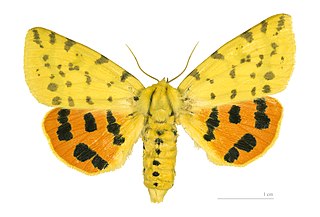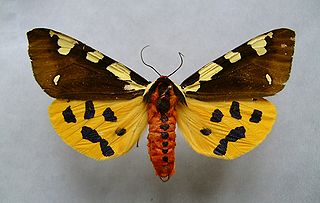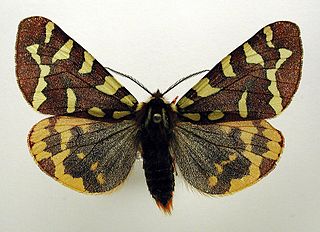
Arctia is a genus of tiger moths in the family Erebidae. Therein, it belongs to the subtribe Arctiina in the tribe Arctiini in the subfamily Arctiinae. Species are well distributed throughout North America, Palearctic, India, and Sri Lanka.

Arctia menetriesii, the Menetries' tiger moth, is a species of tiger moth in the family Erebidae. It was first described by Eduard Friedrich Eversmann in 1846. It is found in Karelia, Oktyabrskoe, northeastern Kazakhstan, Altai Mountains, Sayan Mountains, Evenkia, Yakutia, the central Amur region, Primorsky Krai and central Sakhalin. It was believed to be extinct in Fennoscandia, but the species has been recently recorded in Finland.

Diacrisia purpurata, the purple tiger, is a moth of the subfamily Arctiinae. The species was first described by Carl Linnaeus in his 1758 10th edition of Systema Naturae. It is found in Europe, Anatolia, Syria, Transcaucasus, Central Asia, southern Siberia, Mongolia, Amur Region, northern China, Korea and Japan (Honshu).

Arctia matronula is species of tiger moth in the family Erebidae. It was first described by Carl Linnaeus in his 1758 10th edition of Systema Naturae. It can be found in central and eastern Europe, Kazakhstan, southern Siberia, northern Mongolia, Amur Region, Primorye, Sakhalin, Kunashir, northern and northeastern China, Korea and Japan.

Watsonarctia is a monotypic moth genus in the subfamily Arctiinae erected by Josef J. de Freina and Thomas Joseph Witt in 1984. Its only species, Watsonarctia deserta, the chaste pellicle, was first described by Max Bartel in 1902. It is found in central and south-eastern Europe, southern Russia, southern Siberia east to Lake Baikal; also in Asia Minor, Armenia, Azerbaijan, northern Iran, Kazakhstan, Kyrghyzstan and Xinjiang in China.

Arctia alpina is a moth of the family Erebidae. It is found in northern Scandinavia, northern Siberia, high mountains of southern Siberia and northern Mongolia; also in Alaska and northwestern Canada.

Arctia lapponica is a moth of the family Erebidae first described by Carl Peter Thunberg in 1791. It is found in northern Eurasia and the Arctic part of North America.

Arctia rueckbeili is a moth of the family Erebidae first described by Rudolf Püngeler in 1901. It is found in Tien Shan, Alai and Turkestan mountains in Central Asia within Kyrghyzstan, Uzbekistan, Tajikistan, and Chinese province of Xinjiang at altitudes 1300–3500 m. The moth flies June to July.
Arctia cornuta is a moth of the family Erebidae. It was described by Saldaitis, Ivinskis and Witt in 2004. It is found in the Turkestan Mountains at the Uzbekistan-Tajikistan border.
Arctia khumbeli is a moth of the family Erebidae. It was described by Otto Bang-Haas in 1927. It is found in the Tian Shan of China.
Arctia seitzi is a moth of the family Erebidae. It was described by Andreas Bang-Haas in 1910. It is found in central Asia, including Kazakhstan and Kirghizia.

Arctia intercalaris is a moth of the family Erebidae. It was described by Eduard Friedrich Eversmann in 1843. It is found in Dzhungarian Alatau, Zailiiskii Alatau, Tien Shan, Alai-Pamirs, Uzbekistan, Kyrgyzstan, Tajikistan, the mountains of Afghanistan, north-western Pakistan and from Kashmir to Kulu.

Arctia testudinaria, or Patton's tiger, is a moth of the family Erebidae. It was described by Geoffroy in 1785. It is found from northern Spain to southern and central France and southern Switzerland to north-eastern and southern Italy. It has also been recorded from Great Britain. The habitat consists of grasslands, slopes, forest edges, clear dry forests, cliffs and mountain slopes, maquis, garrigues and dry meadows.
Arctia ladakensis is a moth of the family Erebidae. It was described by Otto Bang-Haas in 1927. It is found in Tibet and Xinjiang in China.
Arctia bundeli is a moth of the family Erebidae. It was described by Vladimir Viktorovitch Dubatolov and Vladimir O. Gurko in 2004. It is found in Tajikistan.
Arctia allardi is a moth in the family Erebidae. It was described by Charles Oberthür in 1911. It is found in China.
Chelis buraetica is a moth in the family Erebidae. It was described by Otto Bang-Haas in 1927. It is found in Russia and Mongolia.
Chelis glaphyra is a moth in the family Erebidae. It was described by Eduard Friedrich Eversmann in 1843. It is found in eastern Kazakhstan, Kyrgyzstan, the central Tien Shan and China (Xinjiang).

Chelis gratiosa is a moth in the family Erebidae. It was described by Grigory Grum-Grshimailo in 1890. It is found in the western Tien Shan, the Pamir-Alay, Kyrgyzstan, Turkestan, Hissar, Trans-Alai, the Pamir Mountains, Pakistan, Kashmir and western China.










